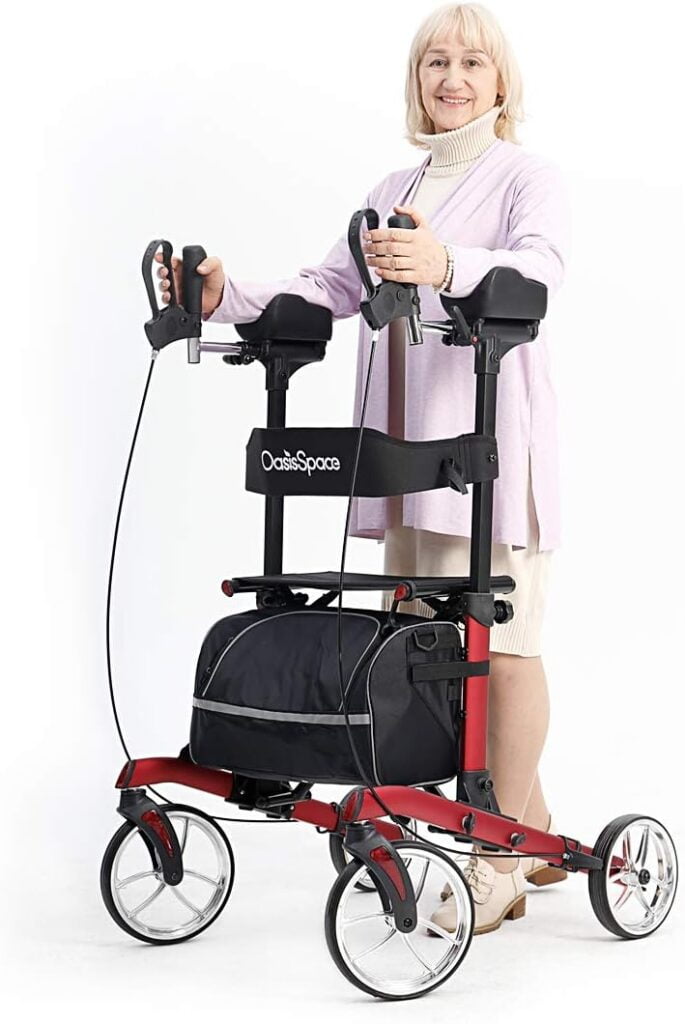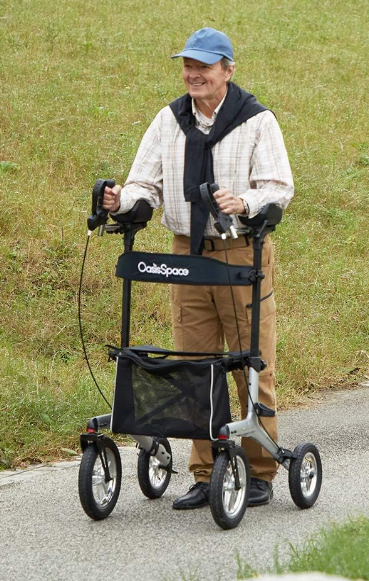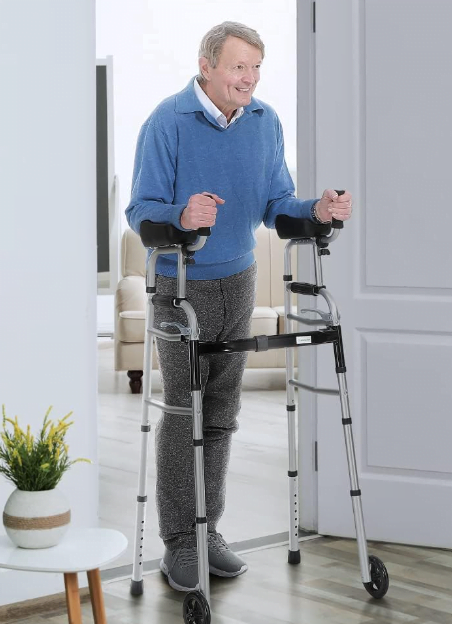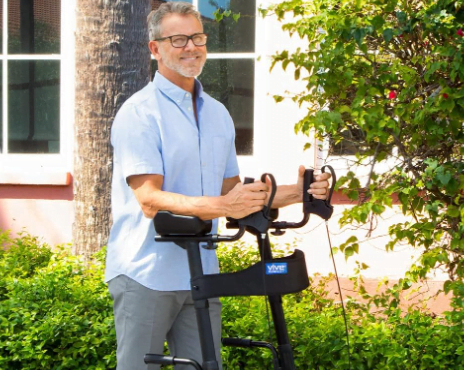Upright Walkers for Seniors #1 Guide
Introduction to Upright Walkers for Seniors
As we gracefully step into our senior years, maintaining mobility and independence becomes a cornerstone of a fulfilling and active life. For many, the key to this independence is finding the right tools to support our changing physical needs. This is where the concept of “upright walkers for seniors” comes into play, offering a beacon of hope and freedom for those who wish to continue moving and exploring with ease and safety.
Upright walkers, a revolutionary adaptation of traditional walkers, are specifically designed to meet the unique needs of seniors. These walkers are not just a means of support; they represent a bridge towards maintaining an active lifestyle, ensuring that age is just a number, not a limitation. In a world where mobility can dictate the quality of life, upright walkers for seniors stand out as a vital tool, empowering our senior community to stride forward with confidence and comfort.
In this comprehensive guide, we delve into the world of upright walkers, exploring how they can transform daily life for seniors. From enhancing mobility to fostering a sense of independence, we understand that every step taken with an upright walker is a step towards maintaining the vibrant and dynamic lifestyle that every senior deserves. Join us as we explore the myriad ways in which upright walkers for seniors can be a game-changer in embracing a life full of movement and freedom. If you’re looking for our review on upright walkers check out this article:
Upright Walkers for Seniors – 2024 Best 5 Review
What are Upright Walkers?
An upright walker is a specialized mobility aid designed to support individuals in maintaining a vertical, ergonomically correct posture while walking. Unlike traditional walkers, it features supports that encourage the user to stand straight, reducing strain on their wrists, back, and shoulders. This walker is particularly beneficial for seniors or those with mobility issues who need assistance but wish to stay as upright as possible.

Differences from Traditional Walkers
The primary difference between upright walkers and traditional walkers lies in the posture they promote. Traditional walkers often necessitate a hunched-over position, causing the user to lean forward, which can lead to discomfort and strain over time. In contrast, upright walkers are engineered to support a natural, upright posture, reducing the risk of back pain and other posture-related issues.
Moreover, upright walkers are generally more user-friendly in terms of maneuverability. With larger wheels and a more stable base, they provide greater ease of movement across various surfaces. Additionally, the ergonomic design typically includes features like padded armrests and seats, offering greater comfort during prolonged use.
Benefits of Upright Walkers for Seniors
Upright walkers for seniors come with a multitude of benefits, key among them being:
- Improved Posture and Comfort: By promoting an upright position, these walkers help in maintaining proper posture, reducing the risk of back and shoulder pain.
- Enhanced Safety and Stability: The design of upright walkers offers greater stability, which is crucial in preventing falls and injuries.
- Increased Confidence and Independence: With the enhanced support and ease of use provided by an upright walker, seniors can experience a boost in confidence, knowing they can move around safely and independently.
- Social and Psychological Benefits: Being able to walk in an upright position allows for more face-to-face interactions, fostering better social engagement and contributing to overall psychological well-being.
- Versatility and Comfort: Features like built-in seats and storage make upright walkers versatile tools for everyday use, whether it’s for a stroll in the park or navigating the aisles of a grocery store.
In conclusion, upright walkers for seniors are not just mobility aids; they are instruments of independence, designed to cater to the unique needs of the senior population. By bridging the gap between necessity and comfort, these walkers play a critical role in supporting an active, independent lifestyle for seniors. Find out more benefits from Vitality Medical: Top 5 Reasons to Buy an Upright Walker to Improve Life.
Upright Walkers for Seniors – 2024 Best 5 Review
How to Use an Upright Walker?
Setting Up Your Upright Walker
Step 1: Adjusting the Height
Ensuring the walker is adjusted to the correct height is crucial for maintaining proper posture. Stand inside the walker and adjust the height so the handles align with your hip joint. This position promotes upright posture and reduces the risk of leaning forward.
Step 2: Understanding the Brakes
Familiarize yourself with the brake mechanism. Most upright walkers have hand-operated brakes similar to those on a bicycle. Practice applying and releasing the brakes to get a feel for how they control the walker’s movement and stability.
Step 3: Customizing for Comfort
Adjust any additional features such as backrest height or armrest width, if available, to ensure maximum comfort and support. These adjustments can make a significant difference in your overall experience with the walker.
Using Your Upright Walker Safely
Walking Technique
- Start Position: Stand upright with your arms comfortably at your sides, gripping the walker handles. Ensure your feet are within the walker’s base for stability.
- Movement: Push the walker forward a small distance, maintaining an upright posture. Step forward with one foot, followed by the other, keeping your weight centered over your feet.
- Pace: Maintain a steady, comfortable pace. Avoid rushing, as it can compromise your balance and the effectiveness of the walker.
Navigating Turns and Corners
- Slow Down: Reduce your speed as you approach a turn.
- Small Steps: Use small, controlled steps to turn the walker, ensuring it remains stable and upright.
- Practice: Turning may feel awkward at first, but with practice, it will become more natural.
Safety Tips
- Wear Proper Footwear: Choose shoes with non-slip soles to reduce the risk of slipping.
- Check the Surface: Before walking, check the floor for any obstacles or slippery areas.
- Regular Maintenance: Periodically check the walker for any loose screws or worn parts and ensure the brakes are working correctly.
Why Choose an Upright Walker?
For seniors contemplating the best mobility aid, the choice often narrows down to comfort, safety, and ease of use. Upright walkers for seniors excel in these areas, particularly from an ergonomic standpoint. Let’s explore why choosing an upright walker can be a transformative decision for seniors.
Ergonomic Advantages for Seniors
Ergonomics plays a pivotal role in the design of upright walkers, ensuring that they adapt to the body’s natural movements. Here are a few ergonomic benefits:
- Reduced Wrist and Hand Strain: The handles of upright walkers are shaped to provide a comfortable grip, reducing the strain on wrists and hands, a common issue with traditional walkers.
- Adjustable Features: Many models come with adjustable heights and armrests, allowing seniors to tailor the walker to their needs, ensuring a comfortable walking experience.
- Ease of Maneuverability: The design of upright walkers makes it easier to maneuver around tight spaces, offering greater independence in various settings, from home to outdoor environments.

Promoting Better Posture and Reducing Strain
One of the most significant benefits of an upright walker is its ability to promote better posture. Traditional walkers often force users to bend forward, which can lead to a hunched back and associated pains. Upright walkers encourage a more natural, upright stance, aligning the spine correctly and reducing the risk of developing posture-related discomfort.
Testimonials and Professional Insights
Hearing from those who use upright walkers and professionals in the field adds a layer of trust and insight into the real-world benefits of these devices. Here are some testimonials:
- User Experience: “Since I started using my upright walker, I’ve noticed a huge difference in my back pain. It’s almost non-existent now, and I love how easy it is to use,” shares Margaret, a 72-year-old user.
- Healthcare Professional’s Perspective: Dr. Simon, a geriatric physiotherapist, states, “Upright walkers are a game-changer for seniors. They not only improve physical health by promoting better posture but also boost mental health by enabling more social interaction and independence.”
- Family Member Insight: “Seeing my father regain his confidence while walking has been heartwarming. The upright walker has given him back his independence,” says John, whose father uses an upright walker.
In conclusion, choosing an upright walker for seniors offers numerous benefits, from ergonomic advantages to promoting a healthier posture and reducing physical strain. These benefits are not just theoretical; they are echoed in the experiences of users and supported by healthcare professionals, making upright walkers a compelling choice for seniors seeking a comfortable and independent lifestyle.
Upright Walkers for Seniors – 2024 Best 5 Review
Features to Consider in Upright Walkers
When it comes to choosing the right upright walker for seniors, several key features need to be considered to ensure the best fit for individual needs. This section guides you through these essential features, highlighting their importance and how they contribute to safety and comfort.
Key Features of Upright Walkers
- Adjustable Height: It’s crucial to select a walker that aligns with your height. An adjustable height feature ensures that the walker can be customized to fit your stature, promoting proper posture and comfort.
- Weight Capacity: Check the weight capacity of the walker to ensure it can support your weight safely. A walker with an appropriate weight capacity ensures stability and durability.
- Wheel Size and Type: Larger wheels tend to navigate better over uneven surfaces, making them ideal for outdoor use. Smaller wheels might be sufficient for primarily indoor use. Also, consider the material of the wheels for durability and the type of terrain they are best suited for.
- Seat and Backrest: For those who need to take breaks or require a seat while walking, choose a walker with a built-in seat and backrest. Ensure the seat is sturdy and comfortable.
- Foldability and Storage: If you travel often or have limited storage space, a foldable walker is a practical choice. Also, consider walkers with built-in storage for convenience.
Safety Features Designed for Seniors
Safety is paramount when it comes to mobility aids for seniors. Here are some safety features to look for:
- Lockable Brakes: Ensure the walker has easily accessible and lockable brakes. This feature is crucial for preventing the walker from rolling away, especially when sitting down or standing up.
- Non-Slip Grips: Handles with non-slip grips provide better control and reduce the risk of slippage.
- Reflective Elements: For those who will be using the walker in low-light conditions, reflective elements can provide added visibility and safety.
Tips for Selecting the Right Walker
- Assess Your Mobility Needs: Consider where and how often you’ll be using the walker. Indoor use might require different features compared to a walker primarily used outdoors.
- Consult with Healthcare Professionals: It’s always a good idea to consult with a doctor or a physical therapist to understand the type of support you need.
- Try Before You Buy: If possible, test out different models to see which one feels most comfortable and suits your needs.
- Read Reviews and Seek Recommendations: Look for reviews from other seniors who have used these walkers, and don’t hesitate to ask for recommendations from friends or healthcare providers.
By keeping these features and tips in mind, you can find an upright walker that not only meets your specific needs but also enhances your overall quality of life. Remember, the right walker can be a significant factor in maintaining your independence and mobility.

Using Your Upright Walker Safely and Effectively
Once you’ve selected the ideal upright walker, it’s crucial to understand how to use it safely and effectively. Proper usage not only ensures your safety but also extends the life of your walker. Here are some instructions, tips, and common mistakes to avoid, along with advice on maintenance.
Instructions and Tips for Proper Usage
- Adjusting the Walker to Your Height: Your walker should be adjusted to a height where your arms are slightly bent when holding the handles. This position ensures you’re walking upright without straining.
- Walking Technique: When walking, stay within the frame of the walker for stability. Move at a steady, comfortable pace and avoid leaning too far forward.
- Using Brakes Properly: Always engage the brakes when standing still, especially before sitting down or standing up from the walker’s seat.
- Sitting and Rising Safely: To sit down, back up to the seat until you feel it against your legs, then use the handles to slowly lower yourself. To stand up, use the handles for support and ensure the brakes are engaged.
Common Mistakes to Avoid
- Incorrect Posture: Avoid hunching over the walker; maintain an upright posture for comfort and effectiveness.
- Improper Height Adjustment: Using a walker that’s too high or too low can cause discomfort or even injury.
- Neglecting to Use Brakes: Not using the brakes, especially on inclines or uneven surfaces, can lead to falls.
- Overloading the Walker: Avoid hanging heavy items on the walker, as this can affect its balance and increase the risk of tipping.
Maintenance and Care for Longevity
- Regular Check-ups: Periodically check all parts of the walker, such as wheels, brakes, and joints, for wear and tear.
- Cleaning: Keep your walker clean, especially the handles and seat. Use a damp cloth with mild soap for cleaning and dry thoroughly.
- Storage: Store your walker in a dry, safe place to avoid rust or damage.
- Professional Servicing: If you notice any issues, such as squeaky wheels or loose components, get it serviced by a professional.
By following these guidelines, you can ensure that you’re using your upright walker most safely and effectively. Remember, taking good care of your walker not only ensures your safety but also extends its lifespan, making it a reliable companion for years to come.
Financial Considerations for Upright Walker
Cost Range and Pricing Factors
Upright walkers for seniors can vary significantly in price, typically ranging from $100 to over $400. Several factors affect the cost:
- Features and Quality: Higher-priced models often offer more advanced features, such as enhanced ergonomic design, larger wheels, and additional accessories.
- Brand Reputation: Established brands with a track record for quality and durability may charge more for their products.
- Warranty and After-Sales Service: Walkers with extended warranties or excellent customer service can be more expensive but offer greater peace of mind.
Insurance Coverage and Financial Aid
- Medicare and Insurance: Some insurance plans, including Medicare Part B, may cover part of the cost of a walker if deemed medically necessary. It’s essential to consult your insurance provider for specific coverage details.
- Financial Aid Programs: Some various programs and charities offer financial assistance or discounted rates for seniors needing mobility aids. Research local resources or consult with a healthcare provider for recommendations.
FAQ Section for Upright Walker
Are upright walkers difficult to use?
Upright walkers are designed to be user-friendly. However, it may take a little time to get used to the new walking style. Always follow the instructions and practice in a safe environment.
Can upright walkers be used on all types of terrain?
While many upright walkers are versatile, it’s important to choose a model that suits your primary terrain. Larger wheels are better for outdoor use, while smaller wheels might suffice for primarily indoor use.
How do I know if an upright walker is the right choice for me?
Consider your mobility needs, the level of support required, and any existing health conditions. Consulting with a healthcare professional can provide personalized advice.
Is maintenance of an upright walker difficult?
Basic maintenance, such as regular cleaning and checking for wear and tear, is usually straightforward. Refer to your walker’s manual for specific maintenance instructions.
Can I travel with my upright walker?
Many upright walkers are foldable and designed for easy transport. Check the specifications of your model for its portability features.
Conclusion to Upright Walkers
In this comprehensive guide, we’ve explored the pivotal role that upright walkers play in enhancing the mobility and independence of seniors. From understanding the ergonomic benefits and safety features to selecting the right model and using it effectively, it’s clear that an upright walker can be a life-changing tool for many seniors.
Remember, the key to finding the perfect upright walker lies in carefully considering your specific needs, lifestyle, and budget. We encourage you to take the time to explore your options, consult with healthcare professionals, and potentially try out different models before making a decision.
With the right upright walker, you can look forward to moving with greater ease, confidence, and independence, opening the door to a more active and fulfilling lifestyle.
See our other article on walkers!
Upright Walkers for Seniors #1 Guide
Upright Walkers for Seniors – 2024 Best 5 Review
Best Walkers for Seniors on a Budget
Rollator Walkers vs Regular Walkers, what’s best in 2024?
Walkers for Adults: Great Mobility in 2024
Walkers for Seniors: Our Complete Guide
Three Wheel Walker: #1 Best Picks & Buying Tips for Seniors
Drive Walker with Seat for Seniors – Top 5 in 2024
Upright Walkers for Seniors – 2024 Best 5 Review
JustforSeniors.org – Health & Wellness

